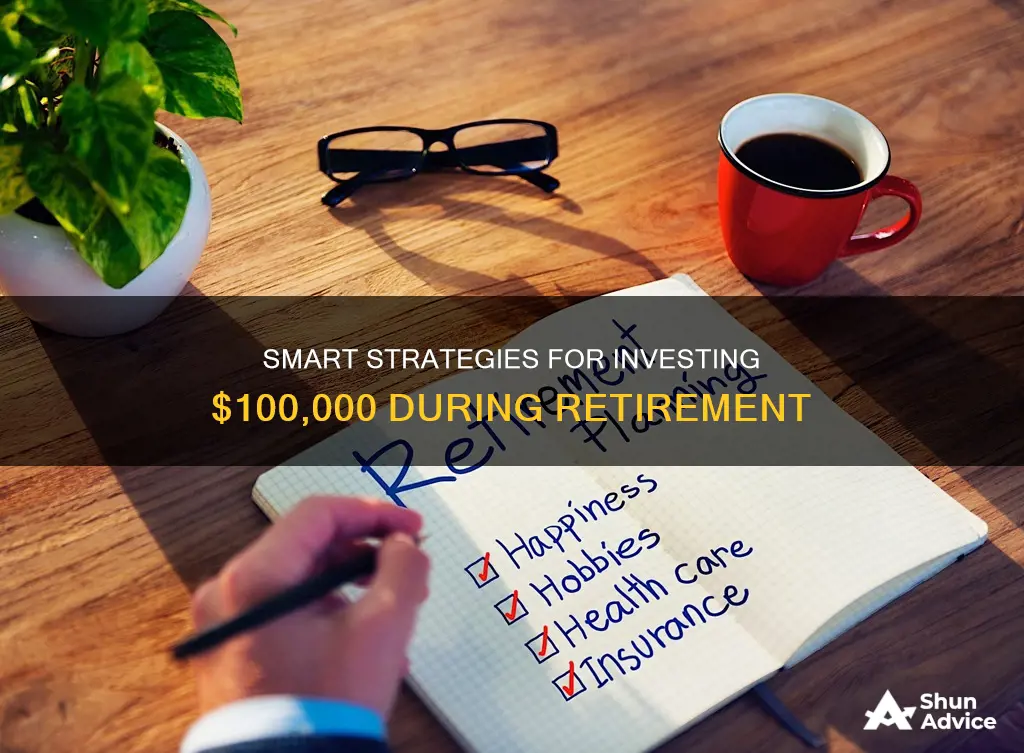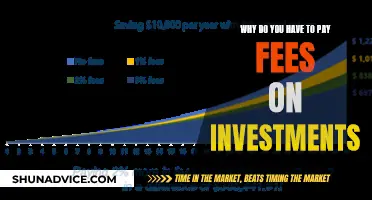
Investing $100,000 during retirement is a significant opportunity to build long-term wealth. Before investing, it is important to assess your financial situation and risk tolerance. If you have high-interest debt, it is advisable to pay it off first. Additionally, consider building an emergency fund of about six months' worth of living expenses.
There are various investment options available, including stocks, mutual funds, ETFs, index funds, dividend stocks, bonds, alternative investments such as real estate and cryptocurrencies, and retirement accounts like IRAs and 401(k)s. It is recommended to diversify your portfolio across different asset classes to manage risk.
You can also seek advice from a financial advisor, who can provide personalized investment strategies based on your goals and risk tolerance.
| Characteristics | Values |
|---|---|
| Assess your financial situation | Determine your investment time horizon and financial needs |
| Determine your risk tolerance | Choose between a higher return and higher risk, or capital preservation and lower risk |
| Decide how you want your money managed | Manage the investment yourself, automate the process, or seek full-service guidance |
| Pad your nest egg | Invest a lump sum to increase savings and maximise retirement accounts |
| Handle your taxes | Be aware of the tax implications of the type of account you use to invest |
| Stay vigilant about fees | Avoid high investment fees to retain more of your money |
| Reallocate your portfolio | Review your asset allocation and risk tolerance |
| Consult a financial advisor | Seek professional advice to optimise your savings and manage your investments |
What You'll Learn

Assess your financial situation
Before investing $100,000 for retirement, it is crucial to assess your financial situation and ensure your finances are in good order. Here are some key considerations:
- Debt repayment: It is generally advisable to prioritise paying off high-interest debt, such as credit card debt, before investing. The average credit card interest rate is around 15-20%, which is higher than the average stock market return, so eliminating this type of debt can be a wise financial move.
- Emergency fund: Building an emergency fund is essential to cover unexpected expenses or financial hardships, such as job loss, medical bills, or car repairs. Aim to save enough to cover at least three to six months' worth of living expenses.
- Retirement savings: If you haven't already, consider contributing to tax-advantaged retirement accounts, such as a 401(k) or an individual retirement account (IRA). These accounts offer tax benefits that can help maximise your savings for retirement.
- Risk tolerance: Understanding your risk tolerance is vital before investing. It refers to your willingness to accept market volatility and the potential losses that may occur. Those with a higher risk tolerance may opt for more aggressive investments, while those with a lower risk tolerance will prioritise capital preservation.
- Financial goals and time horizon: Define your financial goals and the time frame within which you want to achieve them. Are you saving for retirement, a down payment on a house, or your children's education? Do you need the money in the short term or the long term? Your answers will influence the types of investments you choose.
- Investment knowledge and involvement: Decide how involved you want to be in managing your investments. Do you want to actively pick and manage your investments, or would you prefer a more hands-off approach? You can choose to invest on your own, use a robo-advisor for automated investment management, or seek the personalised advice of a financial advisor.
By thoroughly assessing your financial situation and considering these key factors, you can make more informed decisions about investing $100,000 for retirement and ensure that your investments align with your goals, risk tolerance, and time horizon.
Investments After Loss: A New Chapter
You may want to see also

Determine your risk tolerance
When determining your risk tolerance, it's important to understand your goals so you don't make a costly mistake. Your time horizon, or when you plan to withdraw the money you've invested, can greatly influence your approach to risk.
Your time horizon depends on what you're saving for, when you expect to begin withdrawing the money, and how long you need the money to last. Goals like saving for college or retirement have longer time horizons than saving for a vacation or a down payment on a house. In general, the longer your time horizon, the more risk you can assume because you have more time to recover from a loss. As you near your goal, you may want to reduce your risk and focus more on preserving what you have—rather than risking major losses at the worst possible time.
Your risk tolerance refers to the amount of financial risk you're comfortable taking when investing. Market volatility is unavoidable, and investment values are constantly in flux. This can be triggered by the strength of the economy, global crises, disruptions within certain industries, or positive or negative earnings reports. Your risk tolerance describes how much investment risk you can reasonably stomach. This can vary from one investor to the next.
- How many years do you have until retirement? You may be comfortable taking on more risk if you have a longer time horizon.
- What are you investing for? Aside from retirement, do you have any other specific investment goals? That may include buying a home or starting a business. If you're working toward a short-term financial goal, you might opt for low-risk investments to minimize potential losses.
- How do you feel about risk? This comes down to your personality and how you navigate uncertainty. Would you be able to handle significant losses?
- How comfortable are you with short-term loss? Given your goals and your time horizon, are you able to absorb a loss in the short term?
- Do you have non-invested savings? If you're keeping a large portion of your savings in cash because you're nervous about investing, this is likely a sign you're risk-averse.
- Do you plan on tracking your investments day-to-day, week-to-week, or only semi-regularly? If you're tracking your investments regularly, are you doing it because you're nervous, or because you're excited about new investing opportunities?
Your age and financial goals can also impact the way you invest. If you're decades away from retirement, you may feel more comfortable with risk because you have time to recover from short-term market swings. But those who are retired or about to leave the workforce may play it safer. A conservative asset allocation might make more sense.
Investing: Why the Fear?
You may want to see also

Max out retirement contributions
If you have $100,000 to invest during retirement, one of the first things you should consider is maximising your retirement contributions. This can be done in several ways, each with its own benefits and requirements.
Firstly, if you have a retirement plan through your employer, such as a 401(k) or 403(b), it is recommended to contribute at least enough to receive the full "match" from your employer. Many companies will match your retirement contributions up to a certain amount as a benefit, which is fairly common among employers that offer retirement plans. This is essentially "free money" for employees, so it is a good idea to take advantage of this if you can.
Once you have contributed enough to receive the full match from your employer, you may want to consider contributing the maximum allowed amount to your workplace savings plan. The maximum contribution limit for employees who participate in 401(k), 403(b), and most 457 plans, as well as the federal government's Thrift Savings Plan, is $23,000 in 2024. If you are aged 50 or over at the end of the calendar year, you can also add a catch-up contribution of $7,500 pre-tax.
Another option for retirement savings is to contribute to an individual retirement account (IRA). IRAs are not connected to an employer, and you can contribute to them in addition to your employer's plan. There are several types of IRAs, including rollover IRAs, where you can move your old workplace plans, and Roth IRAs and traditional IRAs, which have different tax implications. The contribution limit for IRAs in 2024 is $7,000, or $8,000 if you are aged 50 or older.
In addition to the above, you may also be able to add after-tax money to your 401(k), which can allow you to contribute beyond the individual limit. These contributions can be withdrawn without taxes or penalties at any time.
By maximising your contributions to these various retirement accounts, you can take advantage of tax benefits, receive free money from your employer, and increase your savings for the future.
UK Investors: Who and How Many?
You may want to see also

Invest in stocks and stock funds
Investing in stocks and stock funds is a popular option for those looking to grow their money over time. Here are some things to consider when investing in stocks and stock funds during retirement:
Determine Your Investor Profile:
Before investing, it's important to assess your financial situation and risk tolerance. Ask yourself how much money you will need and what your investment time horizon is. Are you planning to retire soon or do you have a longer time horizon? Your answers will help determine the level of risk you are comfortable with. If you have a higher risk tolerance, you may allocate more of your portfolio to stocks and be willing to invest in smaller, potentially higher-growth companies.
Diversification:
Diversification is a key principle when investing in stocks and stock funds. This means spreading your investments across different companies, sectors, and asset types to reduce risk. You can invest in individual stocks from various industries or consider stock funds like mutual funds or exchange-traded funds (ETFs) that provide instant diversification. Mutual funds are managed funds that invest in a basket of stocks or bonds, while ETFs trade like stocks and often have lower costs.
Robo-Advisors vs Financial Advisors:
If you're new to investing or prefer a more hands-off approach, consider using a robo-advisor. These digital platforms offer prebuilt portfolios based on your goals and typically charge lower fees than human financial advisors. On the other hand, a financial advisor can provide more personalized guidance and comprehensive financial planning but at a higher cost.
Tax Implications:
When investing during retirement, consider the tax implications of your investments. For example, investing in a tax-deferred account like a 401(k) or IRA can shield your investments from taxes until you withdraw them during retirement. Additionally, consider the capital gains tax, which varies for short-term (held for less than a year) and long-term investments.
Dollar-Cost Averaging:
When investing a large sum like $100,000, consider spacing out your investments over time using a strategy called dollar-cost averaging. This strategy involves investing a fixed amount at regular intervals to reduce the risk of investing a lump sum right before a market downturn.
Remember, investing in stocks and stock funds carries risks, and it's important to do your research and assess your own financial situation and risk tolerance before investing.
The NFT Investor Club
You may want to see also

Consider a financial advisor
If you have $100,000 to invest during retirement, you may want to consider getting help from a financial advisor. Financial advisors can provide valuable insights and guidance tailored to your specific needs and goals. Here are some reasons why working with a financial advisor could be beneficial:
- Expertise and Experience: Financial advisors are licensed professionals with extensive knowledge of the financial markets and investment strategies. They can help you navigate the complex world of investing, offering advice on retirement planning, tax planning, estate planning, and more.
- Personalized Advice: A good financial advisor will take the time to understand your unique circumstances, including your financial situation, risk tolerance, and retirement goals. They can then provide personalized recommendations and create a comprehensive financial plan tailored to your needs.
- Time Savings: Investing can be time-consuming, especially if you're new to it. Financial advisors can save you time by handling the research, analysis, and day-to-day management of your investments. This frees up your time to focus on other priorities.
- Risk Management: Financial advisors can help you understand and manage the risks associated with investing. They can assist in determining an appropriate asset allocation and diversification strategy to minimize potential losses.
- Objective Perspective: It's easy to let emotions influence your financial decisions. A financial advisor can provide an objective, unbiased perspective to help you make rational choices and avoid impulsive decisions.
- Ongoing Support and Guidance: Investing is not a one-time event; it's an ongoing process. Financial advisors offer continuous support and guidance, helping you stay on track and make adjustments as your life circumstances change.
- Access to Resources and Tools: Financial advisors have access to sophisticated tools, software, and research materials that can aid in investment analysis and decision-making. They can also provide you with educational resources to improve your financial literacy.
- Tax and Estate Planning: In addition to investment advice, financial advisors can help you minimize your tax liability and plan your estate. This includes strategies for tax-efficient investing, as well as creating a will, naming beneficiaries, and setting up trusts.
When choosing a financial advisor, it's important to do your due diligence. Ask for referrals from friends and family, interview multiple advisors, and understand their credentials, experience, and fee structure. Ensure they are a fiduciary, legally bound to act in your best interest.
The Great Debate: Mortgage Payments vs. Investing – Where Should Your Money Go?
You may want to see also
Frequently asked questions
Safe investment options for $100,000 include savings accounts, money markets, short-term bank certificates of deposit, and U.S. Treasury bills.
If you're maxing out your retirement accounts and committing to a buy-and-hold philosophy, you can multiply your $100,000 exponentially depending on your investments' performance and how long you have until retirement.
Consult a financial advisor and/or tax advisor to discuss the details of your situation. Generally, you'll receive tax benefits in retirement accounts. While the tax break varies by account type, one common benefit is tax-deferred growth on your investments. If you earn interest, collect dividends or realize capital gains outside of a retirement account, you'll generally be taxed on them.
The best way to start investing for retirement is to start early. By opening a tax-advantaged retirement account and setting up automated, regular contributions, you can get accustomed to the process of saving and investing for retirement.
Target-date retirement funds and bonds are considered safer investment options. However, investing is personal, so assess your own risk tolerance and plan accordingly.







